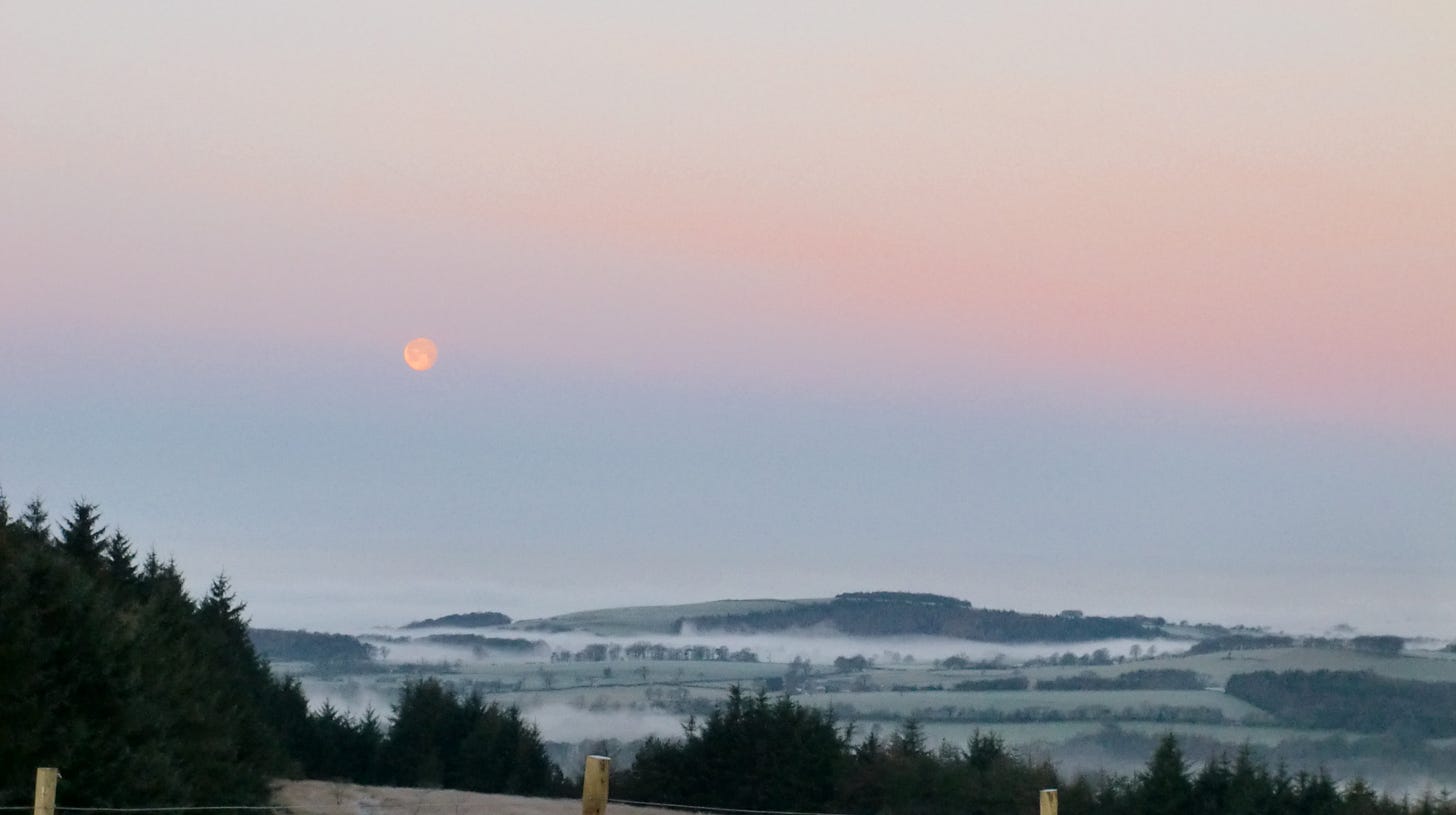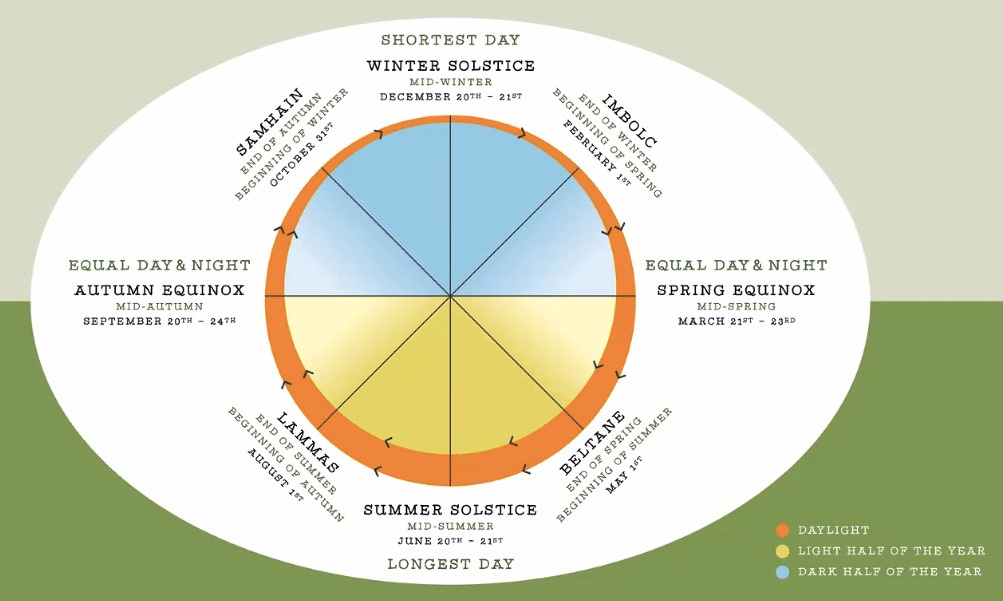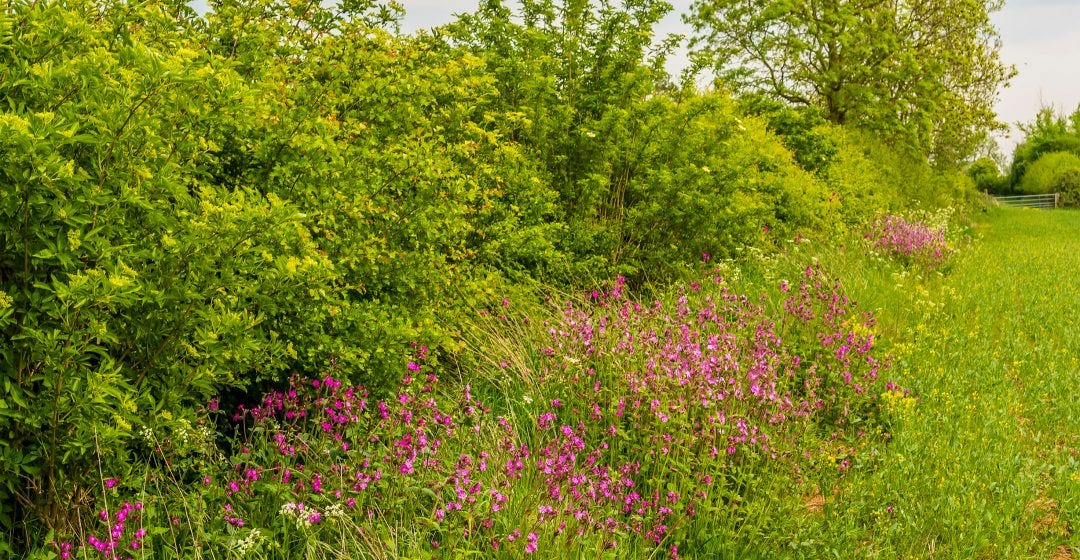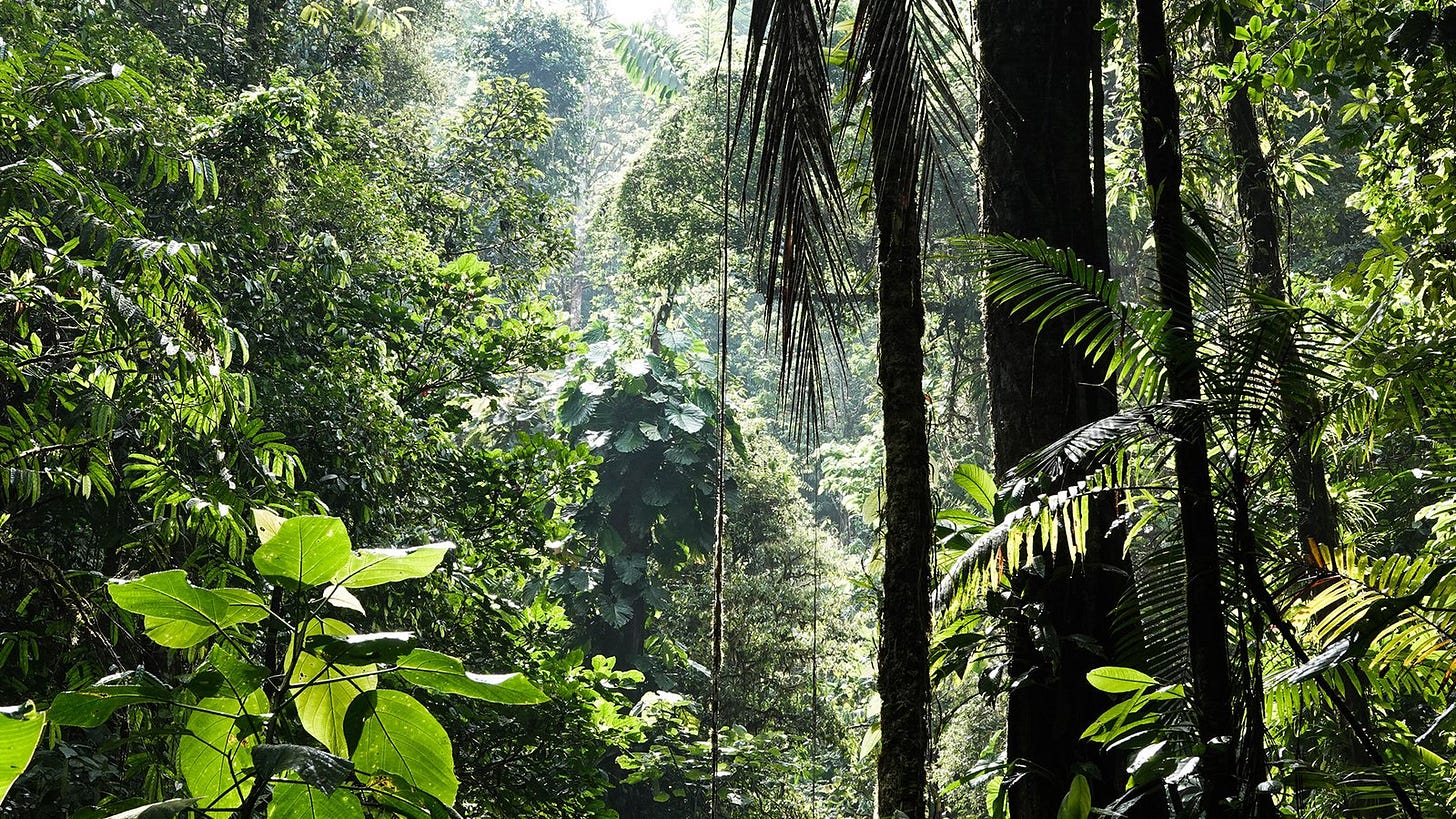Regen Notes 18
Nature, celebrating, connecting, listening in the Equinox
Regen Notes is a newsletter of regenerative news, stories and more, curated by Martin Brown. It is a companion to Zoom Regenerative events and podcasts where we join the regenerative dots, share the themes and work that invigorates, inspires and feeds our curiosity. Falling within the autumn equinox, and during the UK’s Big Green Week, this edition explores nature, celebrating, connecting and listening..
Regen Notes is 100% reader-funded. If you value independent regenerative curation and journalism, please consider supporting by becoming a subscriber.
Of equal day and night, autumn equinox marks the start of the dark time of the year, an important milestone in the years cycle, leading up to Samhain. The harvest moon outside is bright, has from just after sunset and will be until sunrise, giving additional light for the harvest.
The flame-red moon, the harvest moon, Rolls along the hills, gently bouncing, A vast balloon, Till it takes off, and sinks upward To lie on the bottom of the sky, like a gold doubloon. The harvest moon has come,
And all the moonlit cows and all the sheep Stare up at her petrified, while she swells Filling heaven, as if red hot, and sailing Closer and closer like the end of the world. Till the gold fields of stiff wheat Cry `We are ripe, reap us!' and the rivers Sweat from the melting hills
The Harvest Moon - Ted Hughes
And Listen here to the impact that Neil Young’s wonderful Harvest Moon song has had on people lives on BBC Soul Music.
Regenerative designers, practitioners and buildings are aligned with seasons, aware of the impact of sun position, orientation, shading, entering and balancing with nature.
But what does it mean to align and to connect with nature and the seasons? Our first zR ‘In Conversation’ podcast with Sophie Lacey explored how we can rekindle our connections through finding Mindful Spaces and Places. And look out for our next edition, Here Comes the Sun, exploring the relationship of buildings with the sun through Vastu Architecture with John Renwick. It will be available through all good podcast places and here on Regen Notes.
Green Care Code
As part of Great Big Green Week, the University of Derby has launched a Green Care Code with Go Jauntly and the Mental Health Foundation. Simply, Stop – Look – Listen and Enjoy Nature!
“Over recent years our research has shown again and again that simple actions in nature matter. Just taking a moment to notice nature helps build a closer relationship with it. And research shows that this close relationship provides a boost for mental health and pro-nature actions”
See also The Butterfly effect: Can noticing nature boost wellbeing and help address climate chaos? One of the items we’ve used in this research refers to noticing butterflies, 62% of adults infrequently or never take time to notice butterflies. We’ve found that moments noticing butterflies and other simple joys of nature such as listening to birdsong explain mental health and pro-nature behaviours.
Monarch Butterfly. For FutuREstorative I purposely put a monarch butterfly on the cover, acknolweging the monarch butterfly as a key indicator of biodiversity. And the unique sound of millions of monarch butterflies is one of awe …
Hedgerows
One of the core activities of our local UK Longridge Environment Group is a focus on hedgerows, with a watching brief on developments that may seek to remove hedges, legally or not. 26 Habitats celebrated hedgerows “if you wanted to invent a wildlife habitat that represented perfect synergy between humans and nature, you’d design a hedgerow. “ And check out Top ten tips for a healthy hedge from Hedgelink
And is it possible that “in urban areas and crowded city centres with high levels of car emissions, the hedges are a much better solution than trees when it comes to coping with carbon dioxide and other pollutants, because the hedges are planted level with car exhausts”
Arboreal Protection
The Rowan, celebrated through the Trees for Life web pages with its bright red berries, is one of the prominent autumn trees, steeped in folklore and was seen very much as a tree of protection. In the British Isles, the rowan has a long and still popular history in folklore as a tree that protects against witchcraft and enchantment. The tree itself was said to afford protection to the dwelling by which it grew, and residents would make sure not to damage them. To this day rowan trees can be seen growing beside rural dwellings in the Scottish Highlands and Ireland.
Another COP
Whilst COP26 is taking the headlights with its focus on carbon, it also has the vital objective to protect and restore ecosystems, recognising the vital link between nature, carbon and temperatures.
Losses of crucial ecosystems like rainforests and wetlands, as well as animal species, have accelerated even as governments, businesses, financiers, and conservation groups seek effective ways to protect and restore more of the Earth’s land and seas.
COP15 is a two-part UN biodiversity summit that will kick off in October online and finish next May in the southern Chinese city of Kunming. Originally signed at the Rio Earth Summit in 1992 and later ratified by about 195 countries, not including the United States. COP15 is designed to protect the diversity of plant and animal species and ensure natural resources are used sustainably.
Built for the environment
The recently published RIBA report ‘Built for the environment: Addressing the climate and biodiversity emergency with a fair and sustainable built environment’ notes that Nature-based solutions and traditional ecological knowledge, wisdom and technologies are central to both climate and biodiversity emergencies.
Timber
Do all low carbon building solutions revolve around Timber? Simon Wyatt writing in Building points out that whilst timber may appear a panacea, it must be used widely.
“The recent report from the Intergovernmental Panel on Climate Change (IPCC) indicates that the climate emergency is happening now and that we are at “code red”, meaning we need low carbon solutions that have an immediate impact. When we look at timber sequestration, we can see that this lag can take years or even decades to be realised. So, should we be cutting down any trees in a climate emergency?
There is growing evidence that existing trees are far more vital in the carbon agent than planting new trees.
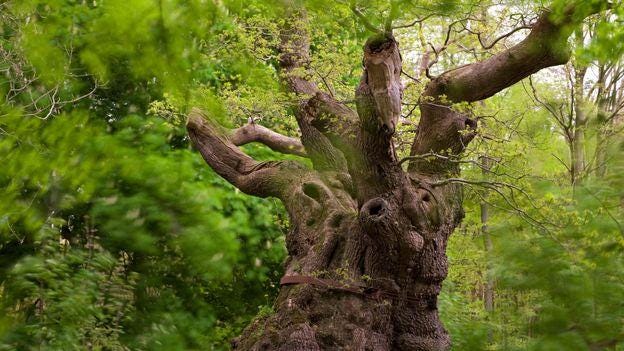
One in three of the world’s tree species are at risk of becoming extinct, according to a recent report by the Global Tree Assessment – the first attempt to estimate the conservation status of all of Earth’s trees.
Well-known species, including magnolias, oaks and maples are among those at risk. More than 400 species have fewer than 50 individuals remaining in the wild, and 142 tree species are already extinct. Human activity is the overwhelming culprit, especially forest clearance for farming, logging for timber and the spread of invasive pests and diseases.
Overstory and Bewilderment
Richard Powers Speaks For the Trees “How did we lose our sense of living here on Earth?” Richard Powers asked. “How did we become so alienated and estranged from everything else alive?”
Richard Powers follows the success of his Overstory Pulitzer-winning novel with Bewilderment, already slated for National Book Awards.
Set in the near future, “Bewilderment” is narrated by Theo Byrne, an astrobiologist whose search for life on other planets feels increasingly futile in the face of the coming collapse of life on Earth. As he struggles with the disasters unfolding around him, Theo fears for his 9-year-old son, Robin, who is consumed by grief over the death of his mother and the fate of the planet.
Richard Powers appeared on BBC Radio 4 Start the Week Climate activism: the next generation, with Simon Mundy and Mya-Rose - a strongly recommended listen via Sounds.
Honourable Harvest
In her 2014 talk at Biopioneers, Robin Wall Kimmerer beautifully talked through the indigenous honourable harvest, of taking only what you need and using all you take. It has become a key theme through her wonderful books and writings and now established as key in regenerative thinking.
A key principle of the honourable harvest is in asking for permission before we take, and to listen and accept the answer. Robin poses the question what how would the world be, if the developer of a proposed shopping mall had to ask permission of golden eye plants growing on the land - and accept the answer? If we had listened we would now not fear our atmosphere.
There is a lesson here too as we use more and more natural materials in construction. In itself a very good thing - but what would happen if we applied honourable harvest principles? - are we being honourable towards nature - or inadvertently propping up bad agriculture practices of monoculture, pesticides and over production? What would a field tell us when we ask for permission to take the straw or hemp. Would it give permission or call for help.
Sleek natural architecture
The long-tailed seamstress bird, (known as tailor bird in Europe) weaving plants and spider web.
Zoom Regenerative
zR re-zoomed on the 14th of September for a new season with a fresh look and format. The unconference style session explored the role of the built environment in light of the IPCC Code Red Report. The session ended with a Call to Adventure - to read books and articles out of reading comfort zone. The list of texts suggested continues to grow over on Linkedin - they will be summarised here in the next newsletter.
Future zR’s include
October 19 with Jessie Buckmaster, Californian Construction
November 16th COP 26 Reflections
December 14th with Rachel Sheila Kan. Regenerative Fashion

